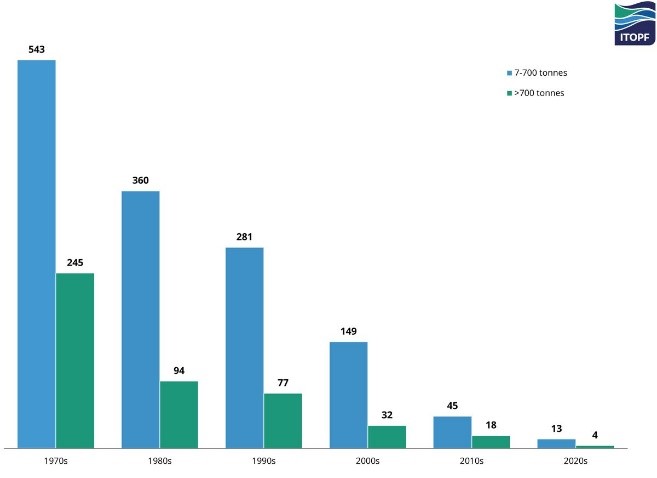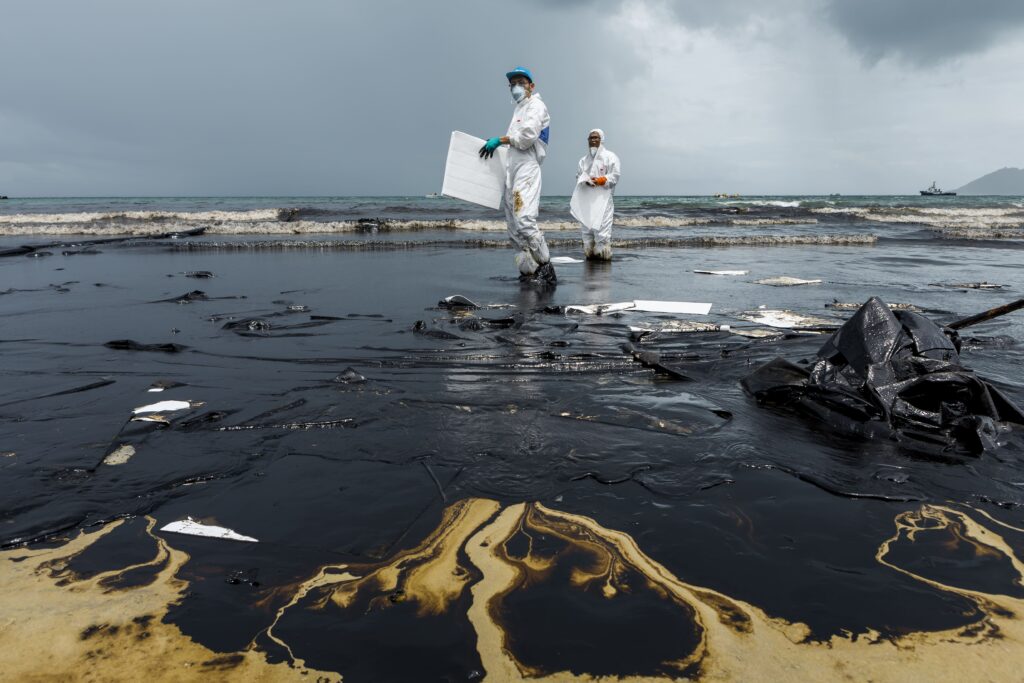Oil spills have left an indelible mark on history as one of the greatest environmental tragedies . Its negative impact on marine and terrestrial ecosystems , as well as on the global economy , has awakened the urgent need to comprehensively address this issue.
Every oil spill is a warning of the dangers facing society. These disasters not only contaminate the oceans and soils, but also put the lives of thousands of species at risk and affect communities that depend on natural resources.
Despite technological advances and efforts to establish stricter regulations, these events continue to occur, although to a lesser extent, but mostly in underdeveloped countries where safety and prevention measures are insufficient.
It’s time to face reality and act! Each incident of this type represents a great threat to environmental sustainability. At present, the world is in an imminent race to face this problem and it is urgent to take decisive measures to avoid irreversible consequences.
History shows that oil disasters have been caused by a variety of factors; such as non-compliance with maintenance, collisions, explosions , subsidence, adverse natural events and others caused by significant human errors. However, it is important to highlight an astonishing reality about what is considered the largest oil spill in history; which was intentionally caused in 1991 during the Gulf War 1 .
Oil spills a historical tragedy
The rise of the oil industry originated the first incidents of spills. During the early stages of exploration and production, the lack of adequate technologies and regulations led to spills that had a significant impact. These incidents served as a wake-up call about the dangers faced during oil operations.
As the oil industry grew, so did the risks. The expansion of exploration into deep water and remote terrain presented unique challenges in terms of spill prevention and response. However, technological advances and the implementation of stricter regulations have contributed to greatly reducing the frequency and magnitude of these.
Some of the most shocking oil spills that have marked international history are mentioned below:
1. Persian Gulf Spill: Called the largest in the world, it was not an accident, it occurred in January 1991 during the Gulf War, when Iraqi forces intentionally released millions of gallons of oil from Kuwait’s Sea Island Terminal north of the Persian Gulf. It is estimated that between 380 and 520 million gallons 1 were released.
2. Deepwater Horizon: It is the largest accidental oil spill in history, it happened on April 20, 2010 in the Gulf of Mexico, when the platform that drilled the “Macondo” oil well, granted to BP and subcontracted with the company Deepwater Horizon, exploded, causing a massive fire and two days later it sank, spilling an estimated 210 million gallons of oil into the waters of the gulf2 .
3.Atlantic Empress: It is the largest spill recorded by a collision between two oil tankers (VLCC). This disaster occurred on July 19, 1979, unleashed by the collision of the Atlantic Empress and Aegean Captain ships, during a tropical storm in the Atlantic Ocean, in areas near the Trinidad and Tobago islands, approximately 90 million gallons of oil overflowed 3 .
4. Mingbulak or Fergana Valley: Known as the largest land oil spill in history. On March 2, 1992, an oil well exploded in the Fergana Valley in Uzbekistan, which released approximately 88 million gallons of crude oil 4 .
5. Nowruz: Distinguished as the largest caused by the collision between a ship and a platform. Occurred on February 10, 1983, when an oil tanker struck an Iranian platform over the Nowruz oil field in the northern Persian Gulf. A month later a different nearby platform was hit by Iraqi strikes. A spill of approximately 80 million gallons was estimated, of which two thirds fell to the seabed 5 .
6. Exxon Valdez: This accident was called the worst environmental disaster in the history of oil spills. On March 24, 1989, the supertanker Exxon Valdez struck a reef off the Alaskan coast, spilling 11 million gallons of crude oil into Prince William Sound 6 . It was the turning point in global awareness of the risks of spills. It was so damaging that it triggered the Oil Pollution Act.
7. Magdalena – Argentina: It has been the largest oil spill in fresh water, it occurred on January 15, 1999, in Magdalena, Buenos Aires province. The Sea Paraná ship collided with the Shell company Estrella Pampeana ship, spilling more than 5,400 m³ of oil into the fresh water of the Río de la Plata 7 .
These incidents have generated significant impacts on both marine and terrestrial ecosystems. However, they have also served to learn valuable lessons that have contributed to the development of improvements and preventive measures towards effective management of the risks associated with oil spills.
Recent Spillage Incidents: The Continuing Tragedy
These incidents originate negative consequences and represent significant challenges in underdeveloped countries, where multiple factors contribute to their frequency and severity. The lack of resources to implement security and prevention measures, the weakness in the application of environmental regulations and the scarce technical capacity are some of the key factors that increase the risk of spills in these regions.
Despite the decrease in these accidents, some of the recent cases in underdeveloped countries reveal worrisome patterns, often related to poor infrastructure, lack of maintenance, and little implementation of safe practices. In addition, the pressure to maximize production and economic benefits leads to irresponsibility and inadequate risk management. Below are some of the recent spills that have generated massive damage:
1. Heavy Crude Pipeline (OCP) – Ecuador: On January 28, 2022, this pipeline failed again; causing a large spill that spread through the Piedra Fina, Quijos, Coca and Napo rivers located in the northern Amazon of the country. This event is added to a succession of events that began in February 2020, with the disappearance of the San Rafael waterfall. On April 7 of that same year, another rupture of the same pipeline originated, as well as that of the Trans-Ecuadorian Oil Pipeline System (Sote), where more than 15,000 barrels were spilled 8 .
2. Pampilla Refinery – Peru: On January 15, 2020, an oil spill occurred during the process of unloading crude oil from the ship Mare Dorium, from the La Pampilla Refinery operated by Repsol and located on the coast of the Ventanilla district, after the strong waves that produced the submarine volcanic eruption near Tonga. 10,396 barrels were spilled 9 .
Addressing the problem of oil spills in underdeveloped countries requires a comprehensive approach. It is essential to strengthen technical capacity, implement effective regulations and encourage the adoption of safer technologies and practices in all operations of the oil industry.
Statistics and global trends of oil spills by ships in the last decades
International Tanker Owners Pollution Federation Limited (ITOPF), maintains a database of tanker oil spills. They have information on accidental spills of persistent and non-persistent hydrocarbons since 1970, except those resulting from acts of war. For historical reasons, spills are classified by size, 700 tons. They have information on more than 10,000 incidents, the vast majority fall into the smallest category, ie <7 tons.
Spill Statistics Shown Over the past half century, statistics on the frequency of spills greater than 7 tonnes have shown a marked downward trend, as illustrated in Figure 1. The average number of spills per year in the 1970s was about 79. This decreased by more than 90% to 6 spills in the 2010s and remains at a similar level during the current decade period 10 .

Oil spills and their threat to current environmental sustainability
Oil spills cause significant damage to marine and terrestrial ecosystems. The contamination of water and soil affects flora and fauna, compromising biodiversity and delicate natural balances. In addition, the toxic components of the oil can persist for years, causing long-term effects.
Local communities experience negative socioeconomic impacts. Loss of livelihoods, especially for those who depend on fishing and tourism, is a direct consequence of spills. Additionally, the effects on human health from exposure to toxic chemicals can be severe and long-lasting.

Sustainable recovery after a spill is a complex challenge. A rapid and coordinated response is required to minimize immediate impacts, but long-term measures to restore ecosystems are also necessary.
Using any advanced cleaning technology speeds up the recovery of the environment. These solutions make it possible to efficiently eliminate oil residues and promote the regeneration of environments in a more sustainable way. Proper planning and implementation of emergency protocols are critical to minimizing impacts and maximizing recovery efforts.
The responsibility of oil companies
The oil industry has a fundamental responsibility in preventing spills and protecting the environment. However, various issues have been identified that need to be addressed to ensure safety and minimize negative impacts.
In the first place, the inefficiency and lack of resources allocated to the implementation of preventive measures and the maintenance of the oil infrastructure can lead to risk situations and increase the probability of spills.
In addition, the little interest and appreciation of the environment on the part of some oil companies has been cause for concern. The pursuit of short-term profit often takes precedence over environmental protection and social responsibility. It is critical that companies understand the importance of using sustainable practices, developing cleaner technologies, and establishing effective spill response mechanisms.
The need for changes and concrete actions in the oil industry is evident. This implies the use of stricter standards, the continuous improvement of risk management systems and the promotion of a culture of environmental responsibility at all levels of the organization, to strengthen its practices and promote innovative technologies and solutions.
In addition, rigorous regulatory oversight and active participation from communities and environmental organizations are required to ensure that standards are met and promote transparency in oil operations.
Conclusion
The magnitude of oil spills goes beyond the number of gallons spilled. The true impact is influenced by various factors, such as location, nearby ecosystems, type of product spilled, presence of tributaries, and proximity to communities.
The extent of the damage caused by a spill based on volume alone should not be underestimated, it is necessary to consider all these elements to understand the severity of the disaster and take effective measures to mitigate its consequences.
The oil industry and regulatory authorities must assume their responsibility in adopting safe and sustainable practices, along with increased investment in research and development of innovative technologies to effectively prevent and address spills, in order to protect our precious natural environment. .
We must continue working together to prevent and control spills, especially in underdeveloped countries, where the consequences are greater due to the lack of immediate response. Only through continued commitment and concrete action can a more secure and sustainable future be achieved for our planet and for generations to come.
References
- britannica.com
- https://es.wikipedia.org/wiki/Deepwater_Horizon#:~:text=El%2020%20de%20abril%20de,millones%20de%20galones%20estadounidenses%3B%20780
- britannica.com
- https://prezi.com/p/ki2p2faotun8/derrame-de-uzbekistan/?frame=64f593f247dcdec110db4c80dd27da1d43b4b7f3
- britannica.com
- https://www.treehugger.com/the-largest-oil-spills-in-history-4863988
- https://es.wikipedia.org/wiki/Derrame_de_petr%C3%B3leo_en_Magdalena
- http://www.dspace.uce.edu.ec/bitstream/25000/28877/1/UCE-FC-CM-CHILIQUINGA%20JESSE%C3%91A.pdf
- https://cnnespanol.cnn.com/2022/01/30/derrame-petroleo-peru-enero-2022-lo-que-sabemos-orix/
- https://www.itopf.org/knowledge-resources/data-statistics/statistics/

